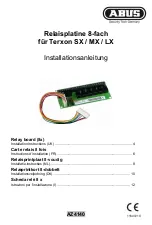
4.3.1
Locked Rotor Protection
Functional Description
The Locked-rotor protection function is a integral part of the thermal model and is used to
protect the motor in the event that the motor fails to start or accelerate after being
energized. The heating in the motor during this period of time can be significantly higher
than the heating at rated current, ranging from 10 to 50 times the normal rated heating.
The time that a motor can remain at a standstill after being energized varies with the
applied voltage and has an I2T limit.
When determining the heat in the motor during this period of time, both the negative and
positive sequence currents are used in the equation that approximates the heat
generated in a locked rotor condition.
The effective heat current I
eff.heat
can be approximated by the equation:
I
eff.heat
² = I₁² + K ⋅ I₂²
where :
• I₁ = the per unit stator positive-sequence current.
• K₂ = weighting factor for the value of I₂ resulting from the disproportionate heating
caused by the negative sequence current component due to the skin effect in the
rotor bar.
The value of K₂ = 6.01 is internally fixed, so that the EMR-3MP0 mimics the thermal
model of Eaton's MP‑3000 and MP‑4000 motor relays.
• I₂ = per unit stator negative-sequence current.
The LRC (Locked Rotor Current) can be set at [System Para / Motor Nominal
Values] »LRC«, see also
158
www.eaton.com
EMR-3MP0
4 Protective Elements
4.3 49 – Thermal Model
















































